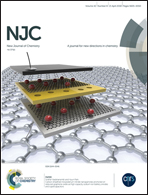Dicarbohydrazide based chemosensors for copper and cyanide ions via a displacement approach†
Abstract
Ligands attached to pyridine dicarbohydrazide were synthesized and characterized by NMR, FT-IR, elemental analysis, UV-visible spectroscopy, mass spectrophotometry, emission spectra and single crystal X-ray diffraction. These ligands were found to recognize copper ions over other metal ions and cyanide ions by a copper complex performing an in situ experiment with turn on–off–on behaviour over different anions in a CH3OH : H2O (9 : 1, v/v solution) medium. These ligands displayed a red shift in their absorption spectra and quenching in their emission spectra when exposed to copper ions via a PET mechanism and a further copper complex was applied for cyanide detection among the other anions. The 1 : 2, 1 : 3, 1 : 2 and 1 : 2 stoichiometric ratios of the ligands (L1–L4, respectively) with copper ions were calculated from a Job plot based on the UV-visible spectra. The S–V plot represents the linearity of the ligands with copper ions. The limits of detection (LOD) of copper ions along with the ligands (L1–L4) were calculated to be 0.12, 0.10, 0.097 and 0.098 μM using emission spectra, respectively. The binding affinities of the ligands with copper ions were determined by various characterization techniques such as FTIR, mass spectrophotometry and electrochemical and optical studies. Furthermore, an in situ experiment was performed for cyanide detection via a metal displacement approach. L1 and L4 with Cu2+ ions showed an affinity towards cyanide ions, with detection limits of 0.31 and 0.53 μM.



 Please wait while we load your content...
Please wait while we load your content...